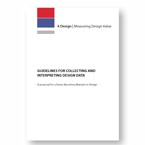
Communication Toolkit
Showing Design’s Unique Delivery
This tool should be applicable to existing and new innovation platforms in companies and other organisations. The model aims at further refining skills and capabilities and at disseminating techniques to measure (and manage) design. The model should also raise general awareness and provide specific insights within our stakeholder groupings into the importance of design as a value-creating factor of production that is often critical in user-centred innovation processes. The tangible results deriving from the capacity to measure design impacts will not only be a motivation but also a strong dynamic factor to increase awareness
>> Download Toolkit Guidelines
>> Download Toolkit Canvas
>> Download Toolkit Trainer Instructions
This tool should be applicable to existing and new innovation platforms in companies and other organisations. The model aims at further refining skills and capabilities and at disseminating techniques to measure (and manage) design. The model should also raise general awareness and provide specific insights within our stakeholder groupings into the importance of design as a value-creating factor of production that is often critical in user-centred innovation processes. The tangible results deriving from the capacity to measure design impacts will not only be a motivation but also a strong dynamic factor to increase awareness
>> Download Toolkit Guidelines
>> Download Toolkit Canvas
>> Download Toolkit Trainer Instructions

Definitions

In order to measure the economic contribution of design, it is required to reach consensus on an economic definition of design. WP1 focuses on defining the economic conceptual framework of design as a factor of production and user-centred innovation tool. WP1 goes beyond the traditional economic view of design as an add-on process in innovation taking place after technology development. It is meant to highlight that design activities focus on the integration of functional, emotional, and social needs and wants of users, consumers, and customers. Thus, the following definition of design is proposed: to design is [to focus on] the integration of functional, emotional, and social utilities.
>> Workpackage-1 PDF
>> Workpackage-1 PDF
Research

Conceptual and qualitative research is to be conducted to order to identify possible guidelines for the measurement of design as a factor of production and user-centred innovation tool. The objective is to shape initial guidelines for analysing and measuring the economic impact, the efforts, and outputs of design. This will lead to a more robust measurement and enhanced statistical analysis of design. Relevant input and output parameters for measuring design as an innovation tool and its resulting value creation will be identified. On the basis of these parameters, new questions to be possibly included in future Community Innovation Surveys (CIS) will be formulated. Identification of the most relevant input and output data will enable firms and policy makers to better understand the impact of design efforts in innovation processes and make their strategic decisions accordingly.
>> Workpackage-2 PDF
>> Workpackage-2 PDF
Parameters

The aim of WP3 was to identify ways in which firms might be asked about design that would result in data which might go some way to helping quantify the benefits of design as an economic factor of production.
As it showed that current questions in the Community Innovation Survey do not match respondents’ perceptions of design as a part of innovation, it became apparent that independent questions on design are needed.
Trials highlighted the inherent difficulties in asking about design, which is acknowledged to be a ‘slippery concept’ to define.
As a result of various rounds of testing, 3 questions proved to be both successful at generating useful data on design as an economic factor of production and were also judged to be understandable and possible to answer in testing. Question 1 asks for a comparison of innovations against competition along a number of dimensions. Question 2 examines the introduction of different types of innovation. Question 3 explores whether the design resources used are in-house, outsourced or a combination of both.
>> Workpackage-3 PDF
As it showed that current questions in the Community Innovation Survey do not match respondents’ perceptions of design as a part of innovation, it became apparent that independent questions on design are needed.
Trials highlighted the inherent difficulties in asking about design, which is acknowledged to be a ‘slippery concept’ to define.
As a result of various rounds of testing, 3 questions proved to be both successful at generating useful data on design as an economic factor of production and were also judged to be understandable and possible to answer in testing. Question 1 asks for a comparison of innovations against competition along a number of dimensions. Question 2 examines the introduction of different types of innovation. Question 3 explores whether the design resources used are in-house, outsourced or a combination of both.
>> Workpackage-3 PDF
Framework

This work focuses on existing and emerging best practices in creating value by design processes and outcomes in companies and other organizations. The conceptual framework for measuring and analyzing design in an economic context is further advanced and tested by exploiting analytical approaches toward other intangible resources and capabilities.
Within the context of R&D and innovation activities, the earlier WP results will be enriched here and
put into new perspectives by testing them through other metrics of intangibles in companies and other
organizations. This will contribute to the shaping of better comparative methods and more robust guidelines for measuring value by design.
To capture the complexity and increasing variety of design and design solutions as part of intangible
resources and capabilities, available data on design applications filed at IP offices
at both national and European levels will be summarized. The data will also be used as inputs for a more comprehensive, empirically based understanding of design as a distinctive element in economic competition.
>> Workpackage-4 PDF
Within the context of R&D and innovation activities, the earlier WP results will be enriched here and
put into new perspectives by testing them through other metrics of intangibles in companies and other
organizations. This will contribute to the shaping of better comparative methods and more robust guidelines for measuring value by design.
To capture the complexity and increasing variety of design and design solutions as part of intangible
resources and capabilities, available data on design applications filed at IP offices
at both national and European levels will be summarized. The data will also be used as inputs for a more comprehensive, empirically based understanding of design as a distinctive element in economic competition.
>> Workpackage-4 PDF
Final Report: A proposal for a future Barcelona Manual on Design

GUIDELINES FOR COLLECTING AND
INTERPRETING DESIGN DATA
HIGHLIGHT-1
Where is design within the main innovation models?
In a technology push model of innovation … design is a styling add-on providing appearance to performance
In a systemic model of innovation design is
-
An integrator of functional, emotional and social utilities (the capacity to satisfy user’s/costumer’s needs and wants)
-
It may also be defined as an integrator of functional problem solving and meaning creation
HIGHLIGHT-2
Technology push is fundamental for innovations focusing on new or better technological functions or performances and when the distance is short between the new invention and the new good, services or experiences desired or needed by the user/customer/buyer.
When the distance is too large, or too complex, between the outcome of research activities or creation activities and what users need or want, systemic models of innovation are required, where the role of design becomes fundamental as integrator of utilities at the very outset of systemic innovation
HIGHLIGHT-3
The economic role of design as a styling add-on providing appearance to performance is minor, compared with the economic role of design as an integrator of functional, emotional and social utilities (the capacity to satisfy user’s/costumer’s needs and wants).
HIGHLIGHT-4
Yet,
Specific legal protection of Industrial design is limited to appearance
HIGHLIGHT-5
Yet,
Current statistics focus on Industrial design data (limited to the protection of appearance)
Current statistics do not provide data on design as integrator, an they provide insufficient data on the linkages and other key data of systemic innovation
New guidelines on collecting and interpreting design data as integrator at the very outset of systemic innovation, are needed for policy makers to take appropriate actions to improve:
- Economic value creation of firms
- Economic value added in nations
- Creation of quality jobs
>> Download here
INTERPRETING DESIGN DATA
HIGHLIGHT-1
Where is design within the main innovation models?
In a technology push model of innovation … design is a styling add-on providing appearance to performance
In a systemic model of innovation design is
-
An integrator of functional, emotional and social utilities (the capacity to satisfy user’s/costumer’s needs and wants)
-
It may also be defined as an integrator of functional problem solving and meaning creation
HIGHLIGHT-2
Technology push is fundamental for innovations focusing on new or better technological functions or performances and when the distance is short between the new invention and the new good, services or experiences desired or needed by the user/customer/buyer.
When the distance is too large, or too complex, between the outcome of research activities or creation activities and what users need or want, systemic models of innovation are required, where the role of design becomes fundamental as integrator of utilities at the very outset of systemic innovation
HIGHLIGHT-3
The economic role of design as a styling add-on providing appearance to performance is minor, compared with the economic role of design as an integrator of functional, emotional and social utilities (the capacity to satisfy user’s/costumer’s needs and wants).
HIGHLIGHT-4
Yet,
Specific legal protection of Industrial design is limited to appearance
HIGHLIGHT-5
Yet,
Current statistics focus on Industrial design data (limited to the protection of appearance)
Current statistics do not provide data on design as integrator, an they provide insufficient data on the linkages and other key data of systemic innovation
New guidelines on collecting and interpreting design data as integrator at the very outset of systemic innovation, are needed for policy makers to take appropriate actions to improve:
- Economic value creation of firms
- Economic value added in nations
- Creation of quality jobs
>> Download here

